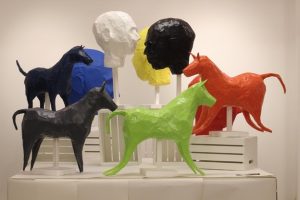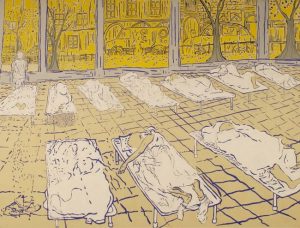CGS Sculpture Artist: Paul Estrada
Arts Everywhere teamed up with the Center for Galapagos Studies (CGS) to call for proposals for sculptures in honor of the 10th anniversary of the Center for Galapagos Studies. Four artists were selected to create a piece of human-sized art (4-7 feet) with recycled and sustainable materials that represent and celebrate the wildlife of the Galapagos Islands.
Learn more about Paul Estrada, one of the four artists chosen for the CGS sculpture project, and his sculpture of a flightless cormorant, Lupita!
About the Artist

Artist Statement/Bio:
Mixed media artist Paul Estrada’s work and process is a synthesis of memories, personal narratives, identity, contemporary culture, anatomy and the nonmaterial.
One of eight children, he celebrates the mixed racial identity of his father’s Mexican and his artistic mother’s Scots-Irish heritage, as well as the incalculable musical and cultural influence of his Jewish stepfather.
While being born into a large multiracial and multicultural Los Angeles home of artists, dancers and musicians in 1975, he credits his greatest artistic influence as his skateboard friends and teachers.
He studied at The Art Students’ League of New York and received a graduate degree in printmaking in 2010 from the City University of New York.
A believer in the transformative work of the artistic process in the individual and the community, he feels that teaching and nurturing the next generation of creative thinkers and problem solvers will always be his most important work.
He has shown work in Mexico, New York and North Carolina. Currently he lives, works and teaches in Chapel Hill, North Carolina.
In 2022 he looks forward to studying in Zimbabwe on a Borchardt Award scholarship, as well as completing a sculpture commission for The University of North Carolina Center for Galapagos Studies.

Who or what are your inspirations?
I draw inspiration from everyday life, past experiences, my natural visual instincts, dreams, anatomy, contemporary culture, trying things I don’t know how to do, my teachers, my students, friends and skateboarding.

One word to describe your art
Dreamy

What’s your dream project?
Put sculptures on rollerskates.

Favorite place you’ve traveled to or somewhere you’d like to go.
I love going to Spain and I would love to go to the Galapagos.
On the CGS Sculpture Project
- Animal: flightless cormorant
- Title: Lupita
- Description: Mixed Media Sculpture
- Materials: Wood, Wire, Tape, Single Use Plastic Shopping Bags
- Size: 144” x 120” x 120”
- Year Completed: 2021-2022
What drew you to apply for the Center for Galapagos Studies Sculpture Project?
I love using trash in my art, I have always been drawn to using discarded materials, it’s easy to be free and creative with waste. Also I love working with the team at UNC Arts Everywhere, they are always thinking outside the box and connecting the dots.

Tell us which animal you chose and why?
The flightless cormorant, because I grew up with ducks as pets. Flightless birds always make me laugh. They seem very much like humans and are silly.
What sustainable and recycled materials did you use and why?
I used single use plastic bags. We can’t recycle them so we might as well make art out of them. They have a beautiful dream-like texture and translucence. There is freedom when using trash and non traditional materials.

How do you hope the community will engage with your piece?
Through the use of form, balance, positive and negative space, texture, and size, I want to create and engage in a playful dialogue with the UNC community about finding beauty, joy, purpose and solutions to the single use plastic problem facing our planet.

What’s your favorite aspect of your sculpture?
I love that it was built in pieces for storage and portability. The balance and use of positive/negative space is quite remarkable. I love the rib cage made of shopping bags. I guess my favorite things are the legs and feet.

You said you wanted your piece to ask “What are the possibilities of using trash in fine art?” and more importantly, “What is the role of the artist during our current environmental crisis?” What’s your take on these questions?
There are many beautiful textures and forms of everyday found objects and trash that can add variety to sculptures and canvases. Using trash has a certain amount of freedom in art because there is no expectation that it has to be art and then of course it ironically becomes art because of its metaphorical and improvisational abilities.
As an artist, I waste and consume quite a lot. It’s my civic duty to recycle, compost, reuse and cut down on consumption. I like to find fun and engaging ways to cut down on waste and incorporate it into my art.
View Paul’s rendition of a flightless cormorant at the FedEx Global Education Center! Be sure to look for the other three pieces as part of this project outside Morehead Planetarium, The Arboretum and the Campus Y.
All photos are courtesy of Paul Estrada. To learn more about Paul, visit his website or check out his Instagram!
